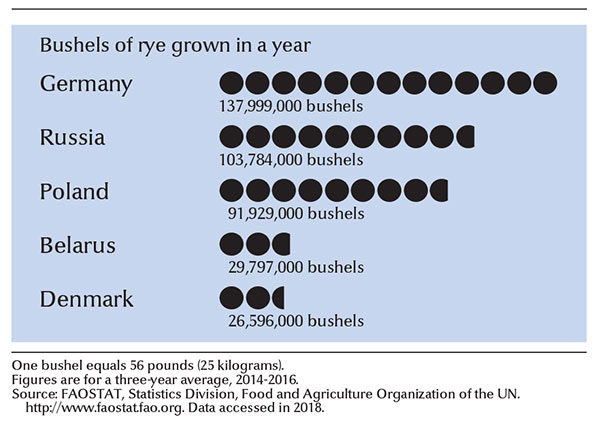Rye is a cereal grain similar to wheat and barley. The plant has slender seed spikes with long, stiff awns (beards). The dark-colored grains grow in pairs. Rye flowers, unlike those of wheat, oats, and barley, open for pollination. The flowers shed their pollen into the air, and the pollen is spread by the wind. Rye is used to make bread and certain types of liquors. Rye probably originated from wild species in eastern Europe or Asia. Wild rye still grows in these regions and in northern Africa.

Production.
Rye is an important crop in the cool climates of northern Europe, Asia, and North America. Germany, Poland, and Russia rank among the world’s leading rye-growing countries. In North America, much of the rye is grown in central Canada, the Dakotas, Georgia, and Oklahoma. The world produces about 540 million bushels of rye annually. A bushel of rye weighs 56 pounds (25 kilograms).
Uses.
In most countries, rye is used chiefly for human food. The food value of rye is nearly as great as that of wheat. But American farmers feed much of the grain to livestock. Rye hay and middlings (medium-sized particles which are a by-product of bran flour milling) are frequently used as livestock feed. Young rye plants make good pasture in spring and autumn. But sometimes, cows that graze on rye give milk that has an unusually strong flavor.

Farmers frequently grow rye to improve or to protect the soil. For example, a crop of rye may be raised alternately with other crops to protect the soil. Then, it is called a cover crop. If it is plowed under before it matures, it is called a green manure crop.
The heavy, black bread of Europe is made from rye. Rye does not contain as much gluten as wheat. Because of this, yeast cannot raise rye dough as easily as wheat dough, and rye bread is heavier and more compact. In the United States, bakers usually add much wheat flour to the rye so that the bread is not so dark as the bread made in Europe. During the past few hundred years, wheat bread has become more popular than rye bread.
Distillers use malt made from rye for rye whiskey and Holland gin. Rye straw is long, smooth, and easy to bend. Packers use the straw as a packing material. Manufacturers use it to make hats, paper, mats, and mattress stuffing. Rye straw is also used in European countries for thatched roofs because it decays less rapidly than most other kinds of straw.
Construction workers use rye to conserve soil. They plant rye in the raw soil along new roadbeds. The plants grow in the infertile subsoil and keep it from eroding.
Cultivation.
Rye grows well in much poorer soils than those necessary for most cereal grains. Thus, it is an especially valuable crop in regions where the soil has sand or peat. Rye plants withstand cold better than other small grains do. Most farmers grow winter ryes, which are planted and begin to grow in autumn. In spring, the plants develop and produce their crop.
Like all cereal grains, rye plants are annuals and new seeds must be planted each year. Most American farmers use grain drills to plant rye. These machines plant the seeds in rows 6 to 7 inches (15 to 18 centimeters) apart. About 84 to 112 pounds of seed are sown per acre (93 to 124 kilograms per hectare). In the United States, rye yields an average of about 30 bushels of grain per acre (75 bushels per hectare). In some European countries, the crop may yield two to three times this amount. Because of the low rye yields and a greater demand for wheat, U.S. farmers usually grow wheat instead of rye whenever possible.
Ergot
is a poisonous fungus that often destroys rye grain. Ergot replaces the grain with a hornlike blackish body several times longer than the normal grain. These ergot bodies poison livestock and human beings who eat the grain or products made from it. This disease is called ergotism. Doctors use small doses of drugs made from ergot to ease migraine headaches, to control bleeding, and as an aid to childbirth.
